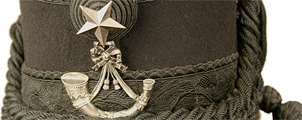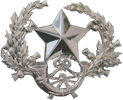Gallipoli Centenary Education Project
‘From the moment a man arrives on the Gallipoli peninsula till he leaves again
he is within range of shellfire no matter where he goes’
Extract from a diary written by Pts Chas R Bow 7th Battalion, The Cameronians (Scottish Rifles)
Gallipoli was one of the most controversial and bloodiest campaigns for the First World War.
Over 500,000 Allied troops fought on this campaign including the 7th and 8th battalions of The Cameronians.
This was to become one of the many battle grounds etched into the history of the regiment.
We’re about to begin our part of the Gallipoli Centenary Education Project, an exciting HLF funded national and international schools education project, which has the potential to create pioneering online learning resources principally designed for and by schools. Centred on the stories of individual soldiers, as well as giving the opportunity to look at how this campaign is viewed by other partner organisations and nations, we hope to help give new perspectives to the campaign from both sides.
The lead partner is the highly respected Gallipoli Association. http://www.gallipoli-association.org/
Over the coming months we will keep you up to date with how our part of the project is progressing. Giving you links to the stories and research the schools have uncovered from not only our own regimental collections, but also the work and stories being produced by all the partner organisations.
The new website for the project has just been launched; http://www.gallipoli100education.org.uk/
You can also follow the project on twitter. https://twitter.com/GallipoliEd
Comments:
Private James Towers VC
The Victoria Cross medal group to Private James Towers VC, 2nd Battalion The Cameronians (Scottish Rifles), sold at auction yesterday (Wed 25th March) with a hammer price of £120,000. Private Towers was the last of three soldiers of the Regiment to be awarded the Victoria Cross for service in the First World War, and was in fact the last Cameronian to earn the famous award.
The war diary of the 2nd Battalion for 22nd December 1918 reads:
“One of the greatest days in the history of the Battalion. At about 10.00 hrs a wire came in stating that the VICTORIA CROSS had been awarded to PTE. JAMES TOWERS of B Company for an Act of the most unsurpassed bravery performed by him on the 6th Oct. this year.”
We are fortunate to have in the museum collection the very signal that was received that day notifying the Battalion of the award of the VC to Private Towers. The signal was taken by Private Harry Podmore, one of the Battalion signallers, and was kept by him as a souvenir. At some point, Private Towers has signed the signal ‘Pte. J. Towers V.C.’
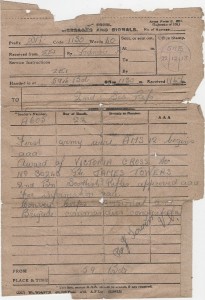
Signal Message, 2nd Battalion Scottish Rifles, dated 22nd December 1918
The war diary for that day continues:
“The Pipe Band were paraded and played PTE TOWERS from Battalion Hdqrs through the village to his billet. He was carried shoulder high by a party of his own platoon & received a great ovation from the whole Battalion.”
With the fighting only ending a matter of weeks earlier, on 11th November, the men truly had reason to celebrate news of the award.
You can browse and search for more fascinating objects in the museum collection by using our online Collections Browser – http://www.slleisureandculture.co.uk/SLLC/info/206/online_collection
Comments:
Christmas in the trenches with The Cameronians (Scottish Rifles)
As we commemorate the 100 year centenary of the First World War the collections team here at South Lanarkshire Leisure and Culture have been sorting through all the objects and archive we have relating to the First World War. During this process we have come across a number of poignant and interesting objects relating to Christmas in the trenches.
For most soldiers Christmas Day in a theatre of war would be like any other day perhaps with the added bonus of a few extra cigarettes or cakes to share amongst them. December 1914 in France also saw very cold, wet and muddy conditions so men would have struggled to stay dry and warm for long. These photographs from the museum collection show officers of the 1st and 5th Battalions in the trenches on Christmas Day 1914 with Captain T. R. McLellan playing the bagpipes for the men and Private Coghlan doing his best to cheer up the men by dressing up.
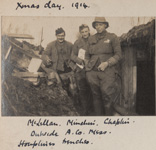
Christmas day in the trenches

McLellan final image

Rfn Coghlan final
There has been much mention recently of the Christmas Truce of 1914, when soldiers of the British Army and German Armies observed a truce for Christmas Day and met in no-man’s land to exchange gifts and play football. The truce was not observed everywhere along the Western Front and fighting continued in many places. Extracts from the war diaries, which have been fully transcribed by our volunteers, The Friends of Low Parks Museum, show that of the three battalions of The Cameronians who were out in France by December 1914, the 1st and 2nd Battalions carried on as normal. The 1st Battalion reported: “Enemy very noisy during night. One man wounded.” The 5th Battalion however reported: “Very little sniping, almost an understanding not to fire but one man killed by a sniper”. The 5th Battalion History book elaborates on this saying:
“On Christmas Eve we could hear the Germans (XIXth Saxon Corps) celebrating the advent of Christmas by singing and merrymaking. We could also hear a brass band behind the houses in their lines playing Christmas carols. For roughly twenty-four hours, Christmas Eve to late afternoon on Christmas day, they ceased firing at us, and we reciprocated. An attempt at fraternisation took place on Christmas day, ” Jerry ” leaving his trench unarmed. Certain souvenirs were exchanged and, if it had been left to the soldiery of both sides, the war would there and then have been declared a draw. But towards late afternoon on Christmas day a stray shot from our right front hit one of ours, No. 6 I 79, Corpl. W. S. Smith, No. 2 Company (from which he died next day). The Saxons opposite us were at pains to let us know that it was a Prussian who had fired the shot which killed Smith. This broke the spell, however, and the war was resumed after a tacit truce of twenty four hours. This truce drew forth an army routine order reminding us that we ‘were in France to fight and not to fraternise with the enemy.”
Christmas could be a lonely time for soldiers when thoughts would turn to loved ones at home. Friends and families would send letters and parcels to the men at the front and often soldiers would send embroidered postcards like the one below to their beloved.

Christmas embroidered postcard final
We recently came across the postcard below in the collection. Writing home to the daughter he has yet to meet, Rifleman Davidson wishes her a “merry merry Christmas…and a merrier and prosperous New Year.” Unfortunately we have been unable to track down exactly who Rfn Davidson was and if he did indeed survive to meet his new daughter. If you have any information which could help us with this then please do let us know.

Rfn W Davidson Xmas Card front final

Rfn W Davidson Xmas Card back final
Comments:
The First World War Centenary Lighting Project in Glasgow
On Remembrance Day, Tuesday 11th November 2014, the story of Glasgow’s part in the First World War was explored through a stunning projection onto the City Chambers at George Square. Artists specialising in the use of light and sound were commissioned by Glasgow City Council to tell the story of Glasgow in the First World War, looking at the contribution of Glaswegians to the war effort, both at home and abroad, and the impact the War had on the city and its citizens.
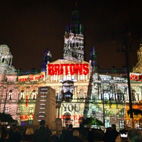
The finished light show being projected onto the City Chambers, November 11th 2014
Using photographs, film, and archival material from a variety of sources, Glasgow’s wartime story was projected onto the iconic City Chambers at George Square on November 11th 2014, accompanied by music, sound and readings of contemporary accounts of Glaswegians at war.
The Cameronians (Scottish Rifles) had strong ties to the City of Glasgow; in 1914, the 1st Battalion were stationed in Glasgow’s Maryhill Barracks, departing there for France in August, 1914. Three territorial battalions of The Cameronians, the 5th, 7th and 8th, were based in Glasgow and recruited almost exclusively from the city.
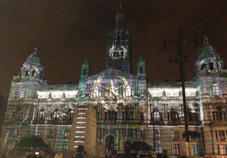
The cap badge of The Cameronians (Scottish Rifles) surrounded by Douglas tartan
Extensive material from the South Lanarkshire Council Museum collection was used by the artists to create the sound and light show. Included among these were personal accounts from officers and men who served with the territorial battalions of the Regiment based in Glasgow.
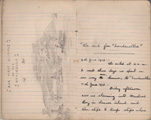
The diary of Private Charles Bow, who served with the 7th Battalion Scottish Rifles at Gallipoli.
Much of the material used from South Lanarkshire’s museum collection had been made available through a variety of in-house digitisation and transcription projects that have brought to light some of the treasures we hold.
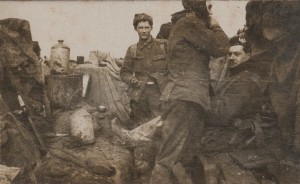
The 5th Scottish Rifles in their trenches, France, 1914.
You can watch the recorded show on the STV Glasgow website: http://glasgow.stv.tv/181281/
Comments:
Welcome to our blog!
Welcome to our blog! Here you can read about objects from South Lanarkshire Council’s museum collection and the work carried out by South Lanarkshire Leisure and Culture museum collections team to care for the collection. There will be stories about interesting objects we have come across in the museum stores, and articles about projects we are involved in. We hope you enjoy reading the posts, please let us know if you have any comments, we’d be pleased to hear from you.
Comments:
Posted: 19/12/2014 by in Collections
Log in
